 Open Access
Open Access
ARTICLE
Optimal Location and Sizing of Multi-Resource Distributed Generator Based on Multi-Objective Artificial Bee Colony Algorithm
1 Economic and Technological Research Institute, State Grid Shanxi Electric Power Co., Ltd., Xi’an, 710075, China
2 Central Southern China Electric Power Design Institute Co., Ltd., China Power Engineering Consulting Group, Wuhan, 430074, China
* Corresponding Author: Lingyun Chen. Email:
(This article belongs to the Special Issue: Key Technologies of Renewable Energy Consumption and Optimal Operation under )
Energy Engineering 2024, 121(2), 499-521. https://doi.org/10.32604/ee.2023.042702
Received 08 June 2023; Accepted 03 August 2023; Issue published 25 January 2024
Abstract
Distribution generation (DG) technology based on a variety of renewable energy technologies has developed rapidly. A large number of multi-type DG are connected to the distribution network (DN), resulting in a decline in the stability of DN operation. It is urgent to find a method that can effectively connect multi-energy DG to DN. photovoltaic (PV), wind power generation (WPG), fuel cell (FC), and micro gas turbine (MGT) are considered in this paper. A multi-objective optimization model was established based on the life cycle cost (LCC) of DG, voltage quality, voltage fluctuation, system network loss, power deviation of the tie-line, DG pollution emission index, and meteorological index weight of DN. Multi-objective artificial bee colony algorithm (MOABC) was used to determine the optimal location and capacity of the four kinds of DG access DN, and compared with the other three heuristic algorithms. Simulation tests based on IEEE 33 test node and IEEE 69 test node show that in IEEE 33 test node, the total voltage deviation, voltage fluctuation, and system network loss of DN decreased by 49.67%, 7.47% and 48.12%, respectively, compared with that without DG configuration. In the IEEE 69 test node, the total voltage deviation, voltage fluctuation and system network loss of DN in the MOABC configuration scheme decreased by 54.98%, 35.93% and 75.17%, respectively, compared with that without DG configuration, indicating that MOABC can reasonably plan the capacity and location of DG. Achieve the maximum trade-off between DG economy and DN operation stability.Keywords
In recent years, the awareness of environmental protection has gradually gained popularity. The proportion of distributed generation (DG), which is dominated by renewable energy sources such as photovoltaic (PV) and wind power generation (WPG), is gradually increasing. Reasonable access to DG can improve the voltage distribution of DN by changing the power flow distribution of the distribution network (DN), reducing the system’s active network loss, and reducing voltage fluctuations [1,2]. However, the output of WPG and PV is related to wind speed and solar irradiance, which has strong randomness [3]. Therefore, how to reasonably select the access location and capacity of DG has attracted extensive attention from researchers at home and abroad [4].
Aiming at the research on improving the stability of DN by accessing DG, Reference [5] studied the optimal capacity ratio of wind-light-storage intending to minimize power fluctuation, but it did not consider the impact of accessing DG on the voltage distribution and voltage stability of DN. Based on particle swarm optimization (PSO), reference [6] optimized the capacity of DG to maximize its economic benefits, but does not consider the impact of DG access on the stability of microgrid operation. References [7,8] all planned the location and capacity of DG based on network loss minimization but did not consider the cost of DG and the stability index of DN. Aiming at minimizing line loss, Reference [9] planned the form and capacity of DG access DN but did not take into account the whole life cycle cost of DG and the impact on DN after DG access to DN.
The above studies are all single-objective planning models of DG. However, the location and capacity determination of DG needs to achieve the optimal balance between the economy of DG investment and the stability of DN. The traditional single-objective model cannot achieve the optimal balance between the economy of investors and the stability of DN. Reference [10] planed DG based on bacterial foraging optimization algorithm (BFOA) to minimize power loss index, voltage deviation, and economic index. However, this study does not consider the voltage stability index, and the algorithm used is a multi-objective algorithm based on single-objective weighting, which is subjective. Reference [11] proposed a double-layer programming model for DG selection with constant volume, in which the upper layer model selects the location of DG by targeting loss sensitivity and voltage fluctuation, while the lower layer model allocates the capacity of DG by targeting voltage deviation, fluctuation, and network loss. Both the upper and lower levels of the system aim at voltage fluctuation, and the choice of the objective function is worth discussing. Reference [12] optimized the planning of DG on the IEEE 33 node distribution network topology model by minimizing DG investment cost, network loss, voltage distribution, pollution emission index and meteorological index. The selected index can reflect the impact of DG access on climate, but it does not consider voltage fluctuation. Reference [13] took voltage fluctuation, voltage distribution and network loss of DN as targets to configure DG, but it does not consider the investment economy of DG. Reference [14] based on the artificial hummingbird algorithm (AHA) takes minimum expected total cost, reduction of total prefetch emissions and minimization of prefetch voltage deviation as objective functions to configure DG in the IEEE 33 node distribution network topology model and the actual distribution system in Portugal’s 94-node network, but does not consider the voltage fluctuation index and network loss index when DG accesses DN.
All the above studies have made some contributions to the field of DG planning, but there are still shortcomings. This paper proposes a new method for DG siting capacity determination, and its main contributions are as follows:
(1) In this paper, four typical DG types such as PV, WPG, fuel cell (FC) [15] and micro gas turbine (MGT) are considered for siting and capacity planning. LCC, DN stability index, environmental pollution emission coefficient and meteorological index weights of DG are taken as the objective functions of the DG siting capacity model. These objective functions effectively balance the economy of DG, the stability of DN and the requirements of the meteorological environment, and effectively achieve a tripartite win-win situation.
(2) In this paper, the multi-objective artificial bee colony algorithm (MOABC) based on Pareto is adopted to solve the DG location fixed-capacity model, and MODA, MOGOA and MOPSO were used as comparison algorithms. The results show that MOABC has better optimization ability, and stability, and can obtain the optimal DG location capacity determination scheme.
(3) In this paper, an improved grey target decision scheme based on the entropy weight method is adopted, which can effectively solve the weight subjectivity of multi-objective results obtained from single-objective weighting, making the model solution results more objective and effective.
2 Multi-Objective Optimization Model for DG Planning
This article considers four types of DGs: PV, WPG, FC, and MGT. Eqs. (1) and (2) describe the uncertainty of the PV and WPG output, respectively.
where
where
From Eqs. (1) and (2), it can be seen that the output of PV is mainly affected by the irradiance intensity of the photovoltaic cell when it is working, while the output of the WPG is mainly affected by the wind speed when it is working. Both types of DG are considered stochastic power sources in the site selection and capacity determination problem. In addition, because the power output of FC and MGT can be controlled by changing the fuel flow rate, FC and MGT can be considered as a power source with a constant power output in the site selection and capacity determination problem of DG.
The capacity determination problem of DG location is a multi-dimensional, multi-constraint and multi-objective optimization problem. In this paper, the life cycle cost (LCC), voltage deviation of DN, voltage fluctuation, network loss minimization, minimum tie-line power deviation, meteorological index weight and pollution emission index of four types of DG are used as objective functions to establish a multi-objective optimization model. The reason for choosing the above objective function is that when DG accesses DN, whether the construction of DG is economical and feasible should be considered first. Therefore, this paper takes the LCC of DG as one of the objective functions. Secondly, when DG is connected, the stable operation of DN is particularly important. Therefore, the objective function is to minimize the voltage deviation, voltage fluctuation and network loss of DN, and minimize the power deviation of the tie-line. Finally, it is necessary to consider the degree of environmental pollution after some types of DG (FC and MGT) are put into operation, so the pollution emission index is taken as one of the objective functions. Since the amount of PV and WPG power generation output largely depends on meteorological conditions, to install wind turbines and photovoltaic systems in areas rich in wind and light resources, maximize the absorption of scenic energy and make full use of renewable energy, this paper innovatively sets meteorological indicators as the objective function.
LCC is the sum of all costs in the entire life cycle of a product. The whole life cycle cost is a management strategy with the whole life cycle cost theory as the core. The calculation of LCC is usually carried out every year, which is 365 days [16].
As an economic indicator for evaluating DG LCC mainly includes initial investment cost (IIC), maintenance cost (MC), and recovery cost (RC). The LCC of DG is calculated as follows:
where
(1) Initial Investment Cost
where
(2) Maintenance Cost
where
(3) Recovery Cost
where
2.1.2 DN’s Voltage Deviation, Voltage Fluctuation, and System Network Loss
(1) Voltage deviation index
To ensure that DG can effectively improve the voltage distribution of DN, this paper considers minimizing the voltage deviation of each node in DN as the objective function. The voltage deviation index can be described by the following formula [17]:
where
(2) Voltage fluctuation index
Due to the changes in the distribution of power flow in DN after DG is connected, the voltage fluctuation of DN is significantly increased. Therefore, the standard deviation of voltage within one day is selected to define the voltage fluctuation of DN, as follows:
where
(3) System network loss index
where
2.1.3 Pollution Emission Indicators
This article introduces pollution emission indicators that include carbon dioxide, sulfur dioxide, and nitrogen oxides to measure the total amount of pollutants emitted by DG during operation time in light of countries worldwide committed to building a low-carbon society and using green energy more efficiently to decrease pollution.
where

As can be seen from the above table, photovoltaic systems and wind turbines in addition to the construction period will produce pollution emissions, after the completion of power generation will not produce pollution emissions, belong to clean electricity. However, fuel cells and micro-gas turbines not only produce pollution emissions during construction, but also emit a certain amount of pollution emissions in the environment after the completion of power generation. Therefore, this paper takes the pollution emission index as one of the objective functions, to maximize environmental friendliness.
2.1.4 Meteorological Indicators
This paper proposes an objective function considering the annual average wind speed
where
2.1.5 Distribution Network Tie-Line Exchange Power Deviation
Due to the intermittent nature of the new energy output, large power fluctuations will occur when it is connected to the grid. In this paper, the power stability of the grid is considered in the DG sizing and capacity planning, which is expressed in terms of the daily power deviation of the power tie-line as follows:
where
(1) Transmission line power constraint.
where
(2) Node voltage constraint.
where
(3) DG configuration power constraint.
where
(4) Node power balance.
where
3 Design of Model Solver Based on MOABC-Improved Grey-Target Decision-Making
3.1 Artificial Bee Colony Algorithm
Let ABC be presented as a multi-objective intelligent optimization algorithm to mimic the process of bees collecting nectar in nature. It consists of a food source, leading bees, and follower bees. The solution process is as follows:
(1) The population is initialized based on upper and lower limits, followed by the calculation of initial fitness function values.
(2) The leading bees will continuously update their food sources to ensure the freshness of their food. After updating the food source, bees will update the fitness values and optimal food source according to the new food source. The process of updating the food source is as follows:
where
(3) After updating the food source, the leading bees will share information with the follower bees. The follower bees will then allocate to the food sources.
(4) The bee colony will allocate food based on the information provided by the follower bees, which can be calculated as
where
(5) If the food source falls into a local optimum, it will be abandoned. The scout bees will then generate a new food source based on Eq. (18), which can be calculated as
where
(6) Repeat steps (2) to (5) until the end of the cycle to obtain the optimal food source and fitness value.
3.2 Multi-Objective Artificial Bee Colony Algorithm
Multi-objective optimization problems are different from single-objective ones, as it is impossible to obtain a solution that minimizes all objectives at the same time, only a set of Pareto optimal solutions can be obtained [18]. The flowchart of MOABC is shown in Fig. 1. This section introduces the selection mechanism of MOABC, as follows:
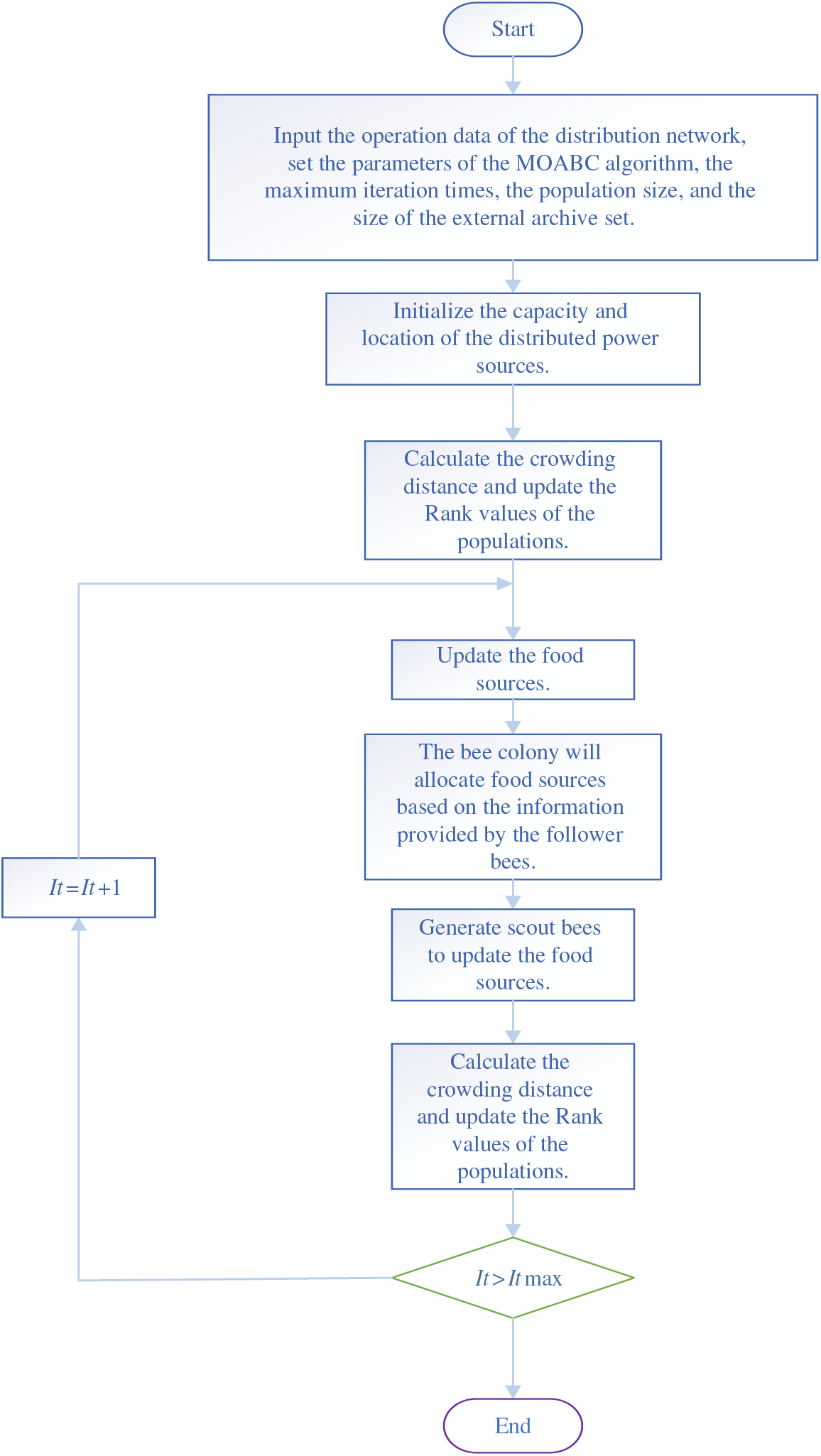
Figure 1: The flowchart of location and capacity selection of DG based on MOABC
(1) An external archive is added to MOABC to store non-dominated solutions, with capacity limited to a fixed number.
(2) A solution update mechanism based on Pareto non-dominated ranking.
(3) Calculate the crowding distance of all populations, and rank populations with the same level based on the size of the crowding distance.
3.3 Improved Grey-Target Decision-Making
In order to avoid the influence of subjective decision on the final result, the grey target decision scheme based on the entropy weight method (EWM) [19] is adopted in this study, and the compromise solution of the Pareto non-dominated solution set is taken as the optimal decision scheme. Firstly, the sample matrix is established based on the Euclidean distance and Mahalanobis distance between the normalized Pareto solution set and each solution set. Secondly, the decision matrix [20] is established according to the cost index formula, and then the bull’s-eye is selected in the gray area formed by the decision matrix. Finally, the weight and entropy of each group of solutions are calculated, and the distance between each group of solutions and the bullseye is calculated based on the weight and entropy. The solution closest to the bull’s eye is selected as the best compromise [21].
(1) Build a sample matrix
The normalized fitness function F of all the solutions is taken as one of the evaluation indexes, and the sample matrix is established. In this paper, we consider adding two related indexes to the sample matrix, one is the Euclidean distance (ED)
In the formula,
(2) Computational bullseye
The operator
where
The decision matrix V is established based on the operator
The selected bullseye is
(3) Establish the weight and Mahalanobis distance
Based on EWM, the weights of each evaluation index can be obtained objectively, and the optimal compromise solution can be selected from Pareto non-dominated solution set. The weights
Each MD to the bullseye can be expressed as:
The non-dominated solutions are sorted according to MD. Each set of solutions in the archive set is considered an independent decision scheme. The solution closest to the bullseye is chosen as the optimal decision solution.
In order to verify the effectiveness of the multi-objective optimization algorithm proposed in this paper [22], a DG siting constant volume simulation test based on IEEE 33 and IEEE 69 standard test node system was designed, and two PV, two WPG, one FC and one MGT were configured. In addition, the optimization results of MOABC were compared with MODA, MOGOA and MOPSO. In order to ensure the fairness of algorithm comparison, the maximum number of iterations and population of the two algorithms were set to 100 and 100, respectively [23]. In addition, the simulation tests of all the examples were completed in MATLAB 2022a environment on a computer equipped with Intel (R) Core (TM) i9-13900K 3.0 GHz CPU and 128 GB memory. Table 2 shows the statistical table of the control parameters of the MOABC algorithm, and Fig. 2 shows the topology structure of the IEEE 33 standard test node system. Table 3 shows the system data of IEEE 33 standard test node [24]. Fig. 3 shows the system topology structure of IEEE 69 standard test nodes, Table 4 shows the system data of IEEE 69 standard test nodes, and Table 4 shows the basic configuration parameters of DN. The basic configuration parameters of DN and the cost parameters of DG are given in Table 5.

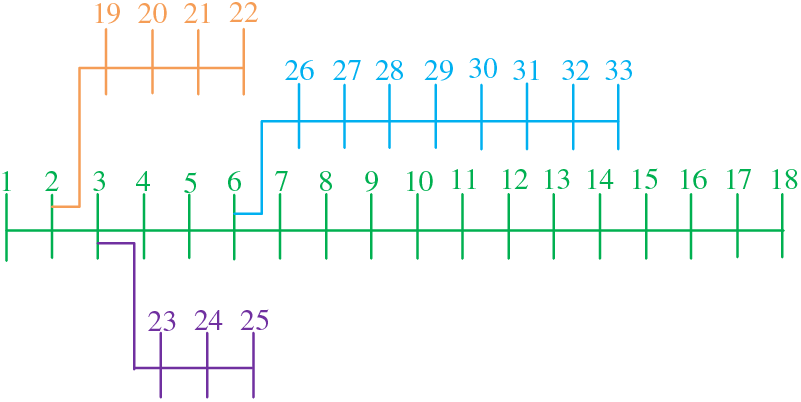
Figure 2: Topology of IEEE 33 standard test nodes system

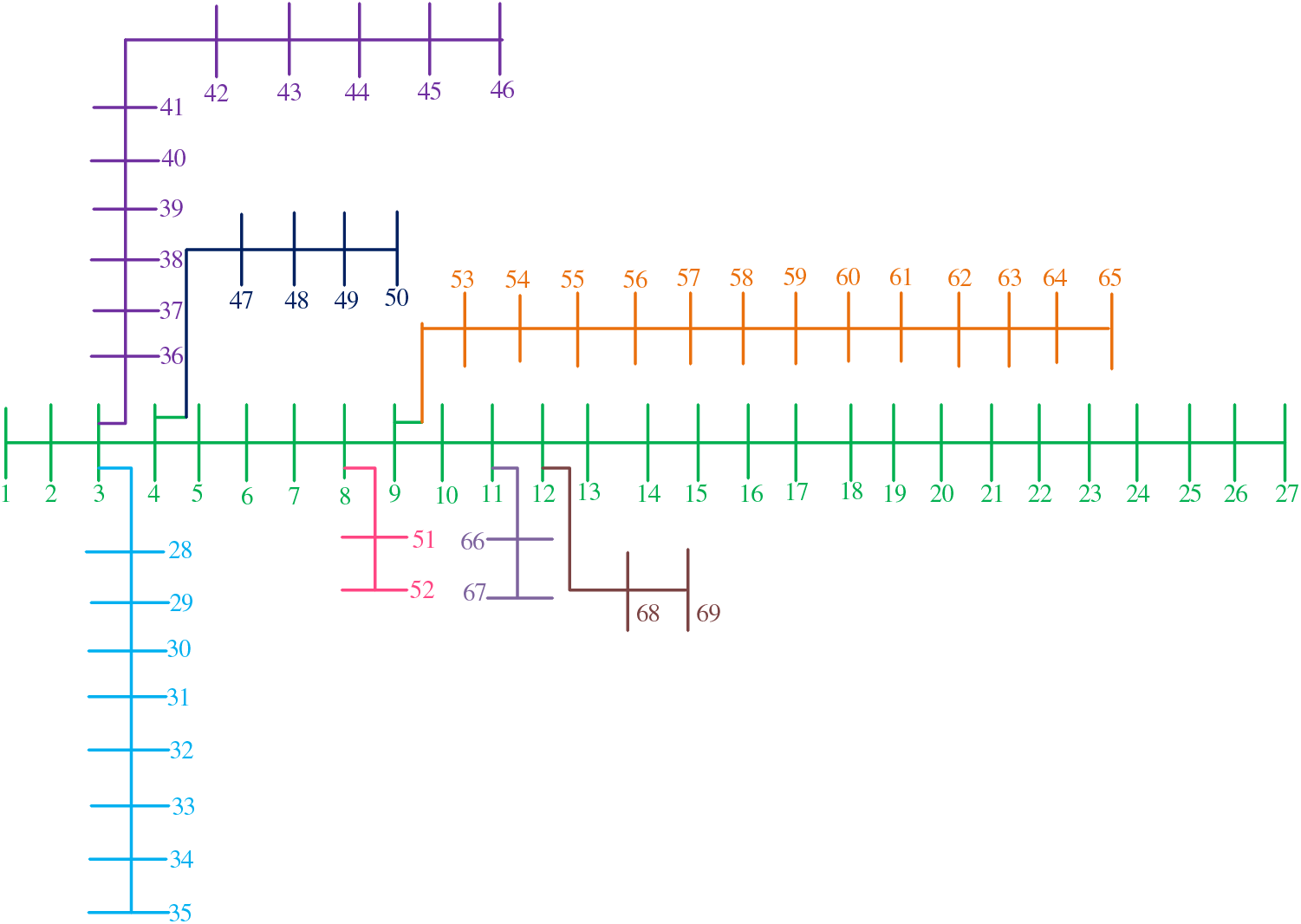
Figure 3: Topology of IEEE 69 standard test nodes system


The MOABC control parameters in the table above are most consistent with the research topic of this paper.
4.1 Performance Comparison of IEEE 33 Node Algorithm
Table 6 shows the upper and lower limits of DG capacity constraints. Table 7 shows the specific configuration schemes of four types of DG obtained by MOABC. Table 8 shows the optimization results of configuring DG in the IEEE 33 node test system via MOABC, MODA, MOGOA and MOPSO, respectively. Compared with no DG configuration, MOABC algorithm costs $



Fig. 4 shows the box plot drawn by each algorithm after 10 independent runs under the same number of iterations, population number and constraints. As can be seen from the figure, among the seven objective functions of MOABC compared with other algorithms, four have good stability and all have good numerical performance, indicating that MOABC has the best stability and effectiveness among the four algorithms.
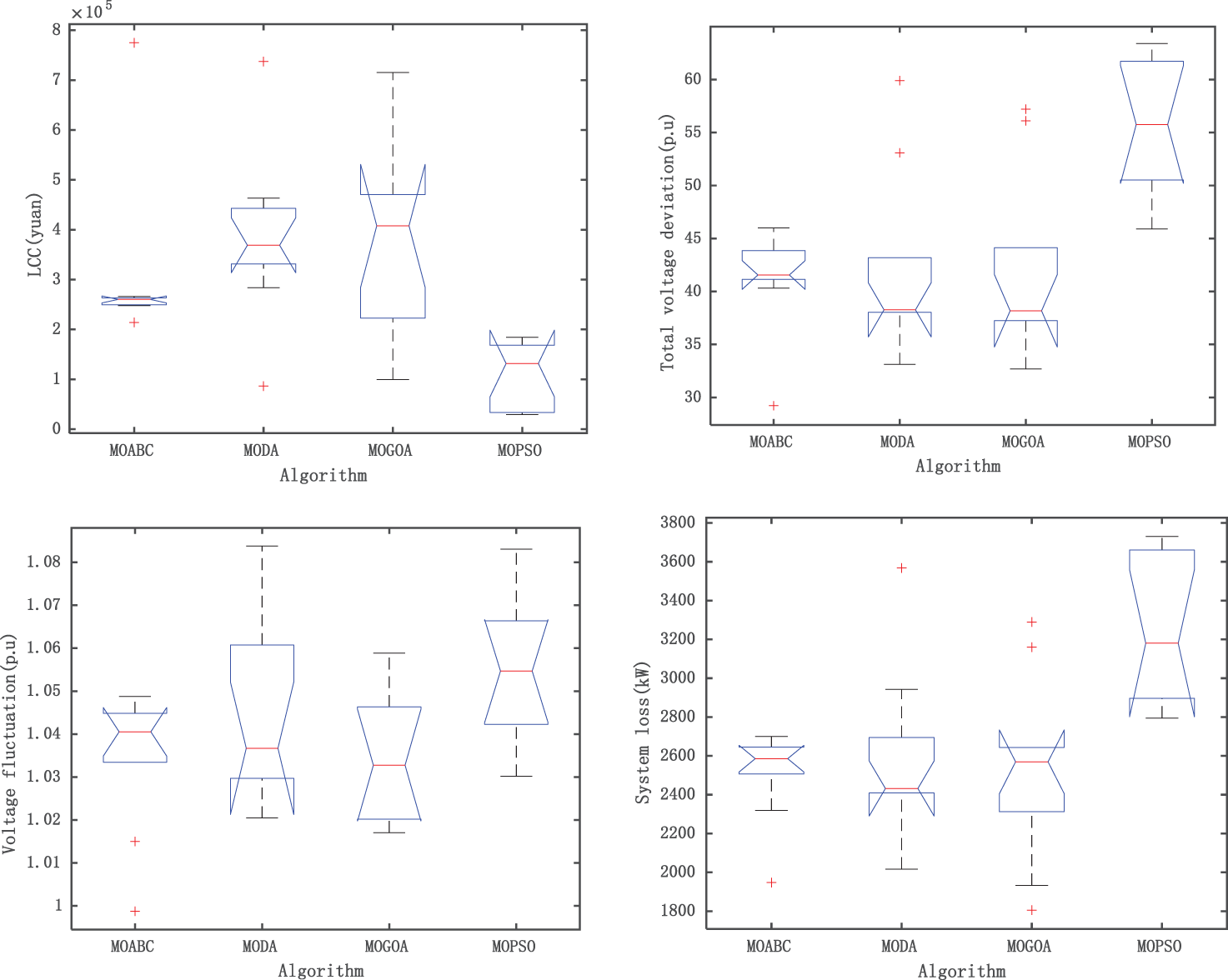
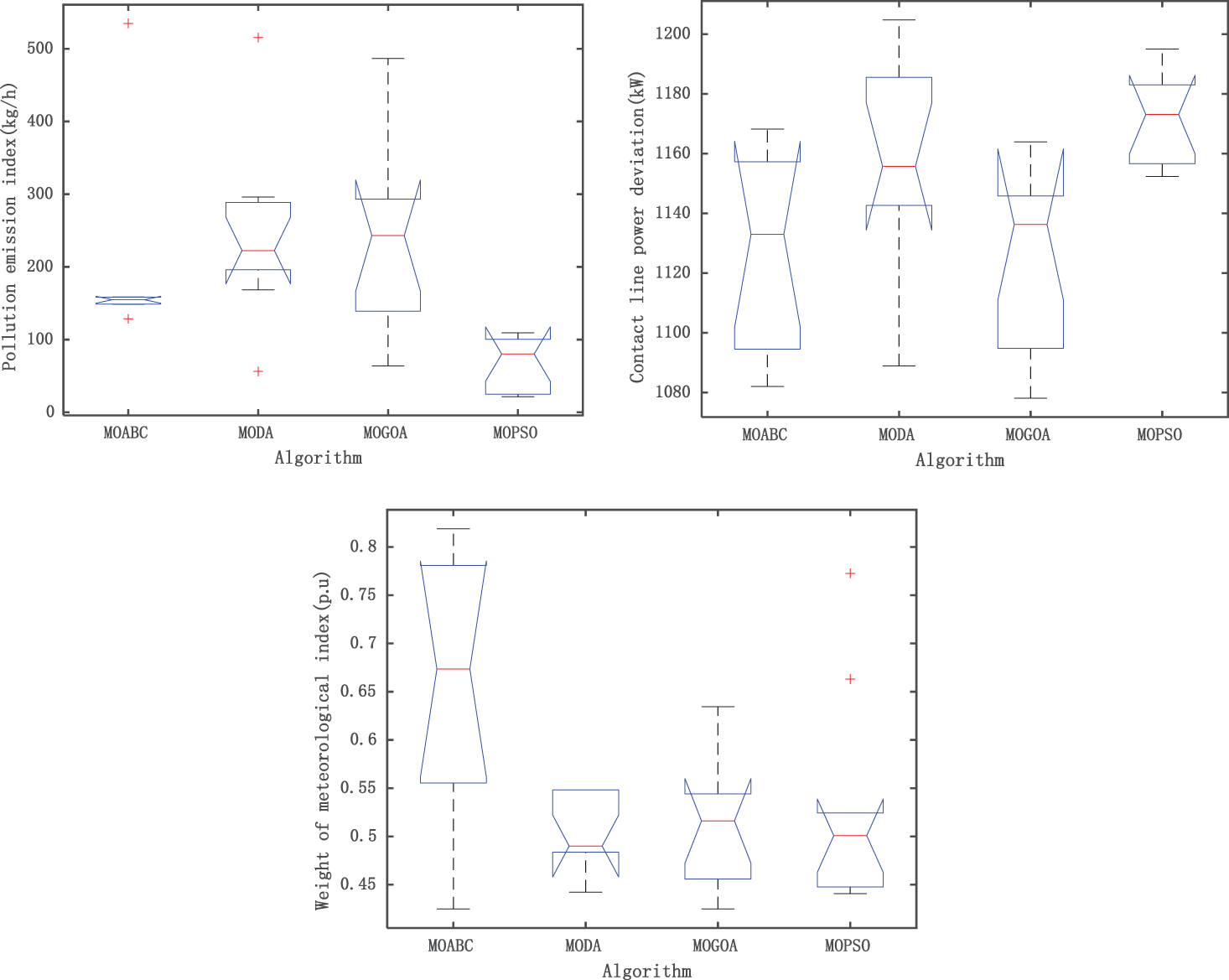
Figure 4: Target function box plot of each algorithm (IEEE 33)
Figs. 5 and 6 respectively show the voltage fluctuation diagram of DN after DG configuration with MOABC and the voltage level distribution diagram of 33 nodes. As can be seen from the figure, the node voltage level of 33 nodes increases after DG is configured, which is closer to 1 p.u. This shows that compared with MODA, MOGOA and MOPSO, the DG configuration scheme selected by MOABC can effectively improve the stability of DN operation and give full play to the positive role of DG in DN.

Figure 5: Comparison of the voltage fluctuation curves of DN before and after the configuration of DG at node 33
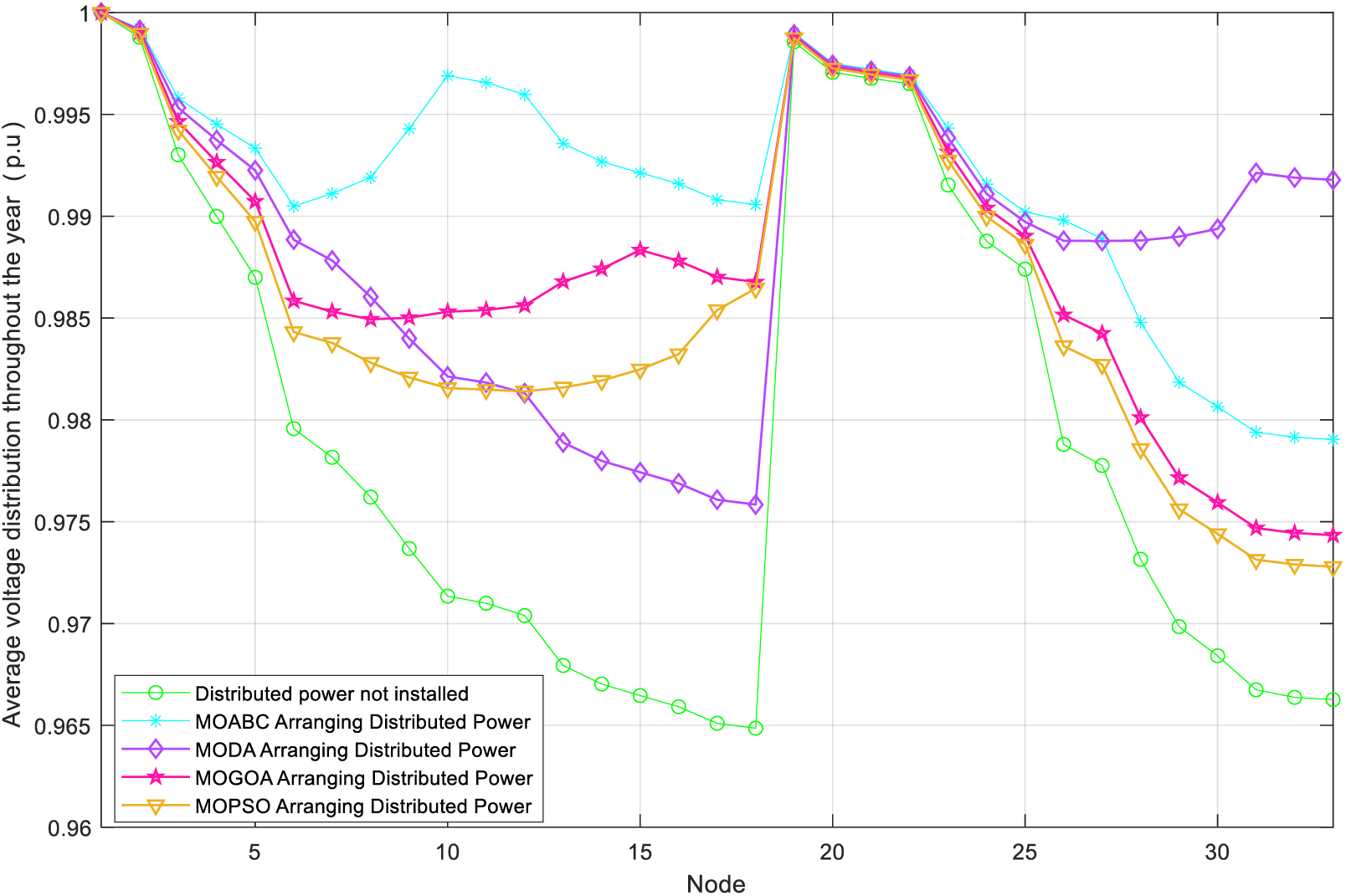
Figure 6: Comparison of node voltage levels of DN before and after configuration of DG at 33 nodes
4.2 Performance Comparison of IEEE 69 Node Algorithm
Table 9 shows the specific configuration schemes of the four DGs obtained by MOABC. Table 10 gives the optimization results of configuring the DG in the IEEE 69-node test system via MOABC, MODA, MOGOA and MOPSO, respectively. Compared to the unconfigured DG, the MOABC algorithm spends $


Fig. 7 shows the box plots of each algorithm after 10 independent runs with the same number of iterations, population size and constraints. From the figure, it can be seen that MOABC has good stability and good numerical performance in six of the seven objective functions compared with other algorithms, indicating that MOABC has the best stability and effectiveness among the four algorithms.
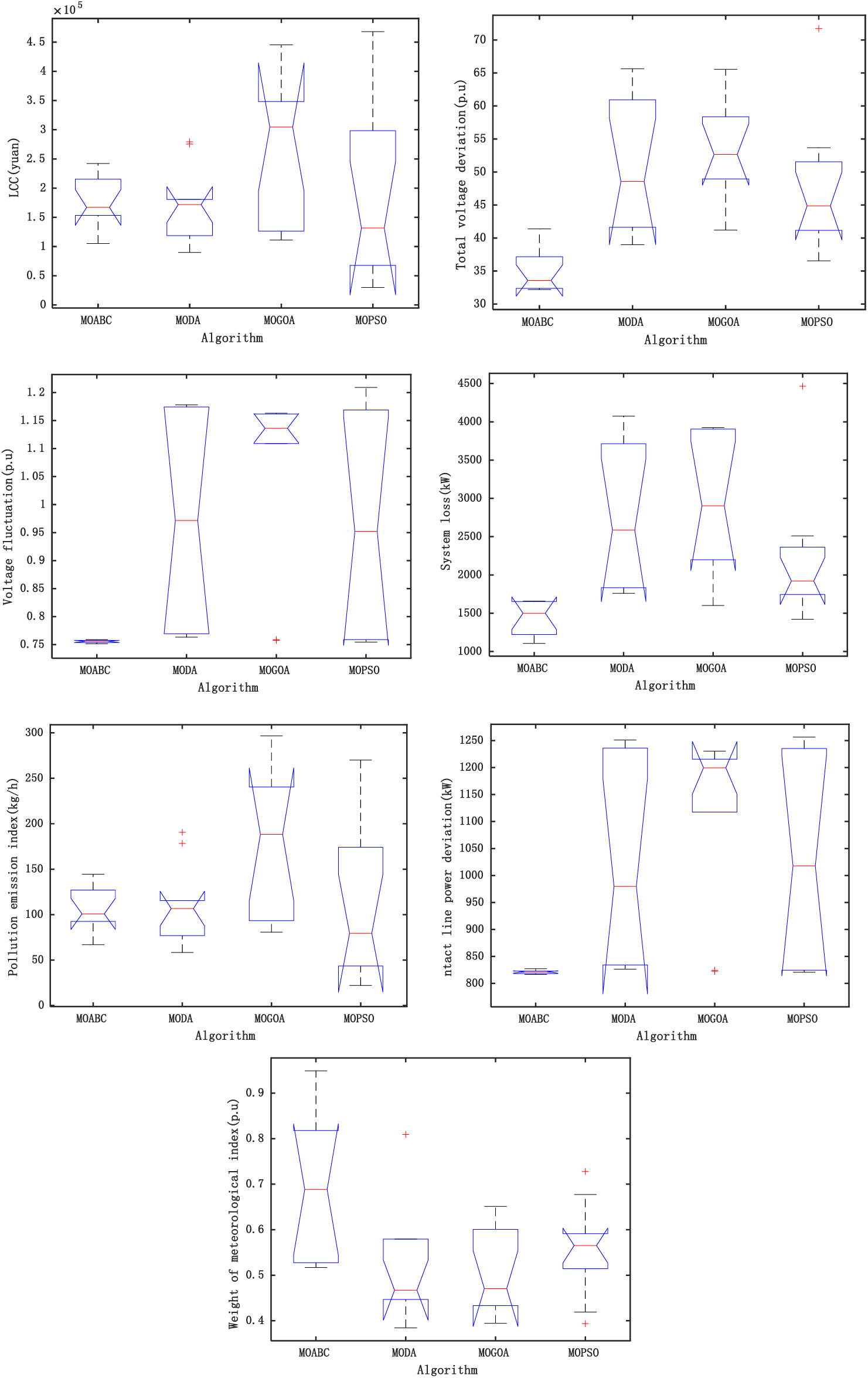
Figure 7: Target function box plot of each algorithm (IEEE 69)
Figs. 8 and 9 show the voltage fluctuation graph of DN after MOABC configured DG and the distribution of node voltage level of 69 nodes, respectively. From the figures, it can be seen that the node voltage levels of the 69 nodes after configuring the DG have increased and are closer to 1 p.u. This shows that the DG configuration scheme that MOABC can select can effectively improve the stability of DN operation compared to the schemes of MODA, MOGOA and MOPSO, and can fully utilize the positive role of DG in DN.

Figure 8: Comparison of the voltage fluctuation curves of DN before and after the configuration of DG at node 69
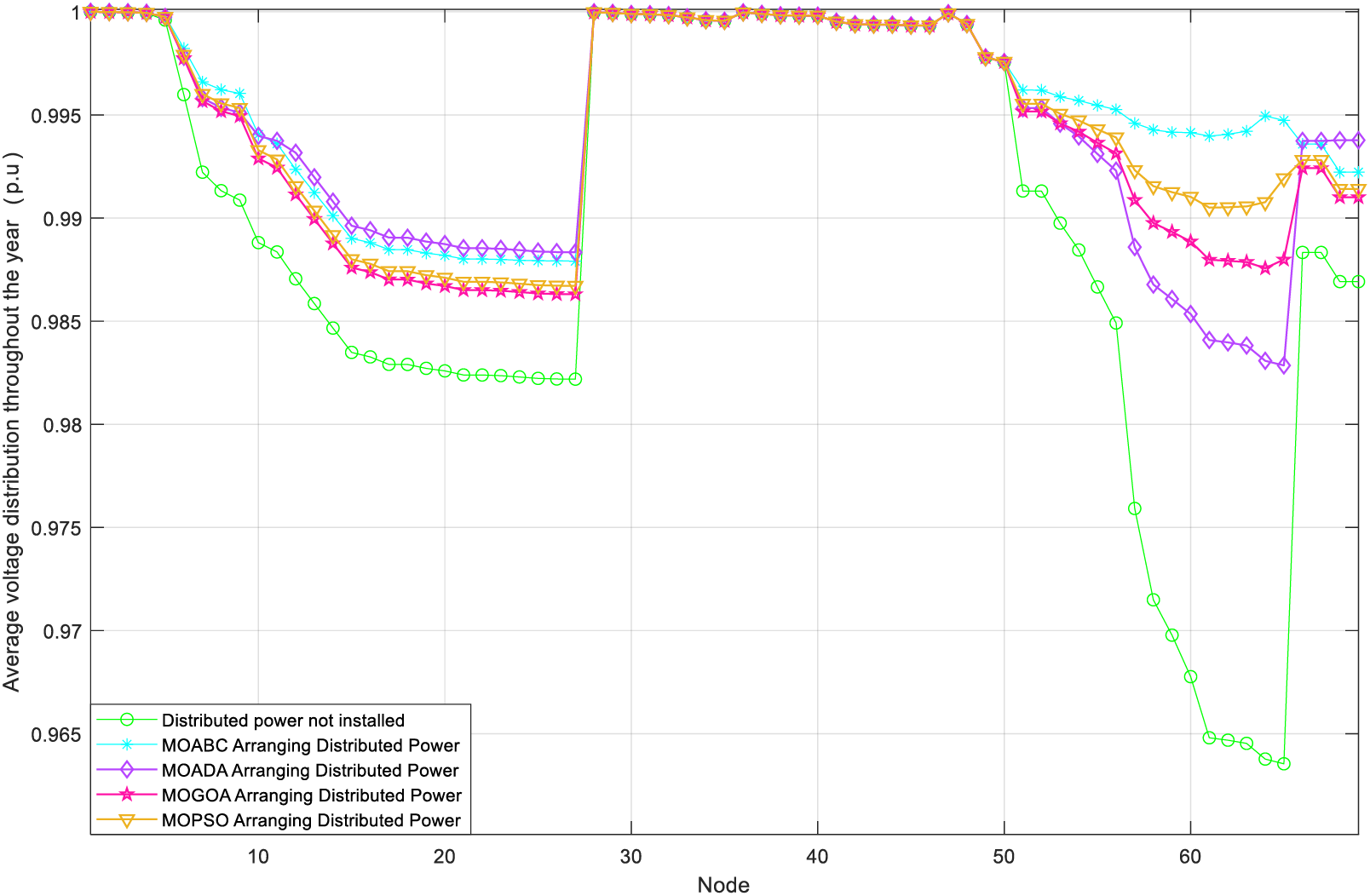
Figure 9: Comparison of node voltage levels of DN before and after configuration of DG at 69 nodes
Considering the operation stability of DN, the investment economy of DG, the environmental friendliness and the full utilization of scenic resources, this paper carries out the capacity allocation location of four typical DG based on MOABC. Based on the improved grey target decision, the optimal compromise solution is obtained. The main conclusions are as follows:
1) This paper establishes a multi-objective programming model based on DG LCC, pollution emission index, meteorological index weight and DN voltage fluctuation, voltage distribution, network loss and tie-line power deviation. It can achieve the maximum improvement of DN stability and economy on the premise of ensuring the interests of DG investors.
2) In this paper, an improved grey target decision scheme based on Euclidean distance and Mahalanobis distance is adopted, which can effectively avoid the influence of subjective decision on the optimal compromise solution.
3) In this paper, a simulation experiment based on IEEE 33 standard node test system is designed to verify the validity of the proposed configuration method. The experimental results show that the total voltage deviation, voltage fluctuation and system network loss of DN decreased by 49.67%, 7.47% and 48.12% respectively after the DG configured by MOABC. The stability of DN operation is effectively improved.
4) In this paper, a simulation experiment based on IEEE 69 standard node test system is designed to verify the validity of the proposed configuration method. The experimental results show that the total voltage deviation, voltage fluctuation and system network loss of DN decreased by 54.98%, 35.93% and 75.17% respectively after the DG configured by MOABC. The stability of DN operation is effectively improved.
In this paper, based on IEEE 33 and IEEE 69 distribution network structure, MOABC is used to locate and determine the capacity of four types of DG. After the optimized configuration of DG is connected to DN, the total voltage deviation and voltage fluctuation of DN are significantly reduced, which is conducive to the more stable and economical operation of DN. It shows that the distribution of distributed generation is crucial to the success of grid planning [25]. At the same time, compared with other schemes, the configuration scheme of MOABC has the smallest configuration capacity, but can improve the stability and economy of DN to the greatest extent, and the configuration scheme is more effective. Secondly, the configuration scheme of MOABC can maximize the utilization of scenery resources and has good economic and environmental protection, and its configuration scheme has better economy, environmental protection and high efficiency. Finally, MOABC has better stability and effectiveness compared to MODA, MOGOA and MOPSO, as shown in the box whisker diagram.
Acknowledgement: Thank you very much for the support provided by State Grid Shaanxi Electric Power Company and Central Southern China Electric Power Design for this paper.
Funding Statement: The authors received no specific funding for this study.
Author Contributions: Qiangfei Cao: Conceptualization, Writing-reviewing, and editing; Huilai Wang: Writing-original draft preparation, Investigation; Zijia Hui: Visualization and contribution to the discussion of the topic; Lingyun Chen: Validation.
Availability of Data and Materials: All data are from a region in Southwest China, and the data used cannot be disclosed according to data confidentiality requirements.
Conflicts of Interest: The authors declare that they have no conflicts of interest to report regarding the present study.
References
1. Li, G. D., Wang, Z., Zhao, F. Z., Hao, S., Zhang, Q. C. et al. (2021). Evaluation of the impact of distributed generation access on distribution network operation index. Electrical and Energy Management Technology, 603(6), 79–85. [Google Scholar]
2. Song, D. R., Liang, Z. A., Xia, E., Yang, J., Liu, J. B. et al. (2023). Overview of wind power life-cycle cost modeling and economic analysis. Thermal Power Generation, 52(3), 1–12. [Google Scholar]
3. Jiao, Y. L., Fan, X. C., Shi, R. J., Wang, W. Q., Liu, S. M. et al. (2022). Optimal configuration of AC/DC hybrid microgrid based on GTMPSO algorithm. Journal of Kunming University of Science and Technology (Natural Science), 47(4), 72–82. [Google Scholar]
4. Yang, B., Wang, J. T., Chen, Y. X., Li, D. Y., Zeng, C. Y. et al. (2020). Optimal sizing and placement of energy storage system in power grids: A state-of-the-art one-stop handbook. Journal of Energy Storage, 32, 101814. [Google Scholar]
5. Wei, W., Fan, Y., Xie, R., Bai, J. Y., Mei, S. W. (2023). Optimal ratio of wind-solar-storage capacity for mitigating the power fluctuations in power system with high penetration of renewable energy power generation. Electric Power Construction, 44(3), 138–147. [Google Scholar]
6. Wang, X., Chen, Z. C., Bian, Z. H., Wang, Y. Y., Wu, Y. M. (2022). Optimal allocation of a wind−PV−battery hybrid system in smart microgrid based on particle swarm optimization algorithm. Integrated Intelligent Energy, 44(6), 52–58. [Google Scholar]
7. Quadri, I. A., Bhowmick, S., Joshi, D. (2019). A hybrid teaching-learning-based optimization technique for optimal DG sizing and placement in radial distribution systems. Soft Computing, 23(20), 9899–9917. [Google Scholar]
8. Boktor, C. G., Youssef, A. R., Kamel, S. (2019). Optimal installation of renewable DG units in distribution system using hybrid optimization technique. IEEE Conference on Power Electronics and Renewable Energy (IEEE CPERE), pp. 129–134. Aswan, Egypt. [Google Scholar]
9. Zhang, X. J., Kong, D. H., Ma, Q. L., Sun, Z. (2023). Research on distributed generation access method based on line loss optimization. Electric Engineering, 590(8), 226–229. [Google Scholar]
10. Liu, K., Liu, D. P., Guo, C., Wang, X., Zhang, Q. S. et al. (2022). DG site selection and capacity planning method in distribution network based on BFOA algorithm. Power Grid Analysis & Study, 50(9), 90–96. [Google Scholar]
11. Yang, Y., Wang, T. (2022). Optimal siting and sizing of distributed generators based on multi-objective double-layer planning. Journal of North China Electric Power University (Natural Science Edition)(In Chinese). http://kns.cnki.net/kcms/detail/13.1212.TM.20220803.1152.002.html [Google Scholar]
12. Yang, B., Yu, L., Chen, Y. X., Ye, H. Y., Shao, R. N. et al. (2021). Modelling, applications, and evaluations of optimal sizing and placement of distributed generations: A critical state-of-the-art survey. International Journal of Energy Research, 45(3), 3615–3642. [Google Scholar]
13. Abdel-Mawgoud, H., Kamel, S., Ebeed, M., Aly, M. M. et al. (2018). An efficient hybrid approach for optimal allocation of DG in radial distribution networks. International Conference on Innovative Trends in Computer Engineering (ITCE), pp. 311–316. Aswan, Egypt. [Google Scholar]
14. Ramadan, A., Ebeed, M., Kamel, S., Ahmed, E. M., Tostado-Veliz, M. et al. (2023). Optimal allocation of renewable DGs using artificial hummingbird algorithm under uncertainty conditions. Ain Shams Engineering Journal, 14(2), 101872. [Google Scholar]
15. Yang, B., Li, J. L., Li, Y. L., Guo, Z. X., Zeng, K. D. et al. (2022). A critical survey of proton exchange membrane fuel cell system control: Summaries, advances, and perspectives. International Journal of Hydrogen Energy, 47(17), 9986–10020. [Google Scholar]
16. Zheng, J. L., Chen, J., Zhao, L. H., Yang, G., Yu, L. (2022). Research progress of life cycle cost technology in domestic power system. Electric Engineering, 563(5), 37–41. [Google Scholar]
17. Wu, X. M., Shi, Z., Fu, Z. Y., Liu, X. Y., Dang, J. et al. (2022). Multi-scene distributed generation planning based on clustering by fast search and find of density peak. Journal of Henan Polytechnic University (Natural Science), 41(2), 117–123. [Google Scholar]
18. Zhang, Y. (2023). MOABC for CSFS. https://www.mathworks.com/matlabcentral/fileexchange/71151-moabc-for-csfs [Google Scholar]
19. Fang, T., Jiang, D., Yang, Y., Yuan, T. J. (2022). Research on business operation mode of hydrogen integrated energy system based on NSGA-II and entropy weight method. Electric Power, 55(1), 110–118. [Google Scholar]
20. Yang, H. H., Wang, J., Tai, N. L., Ding, Y. T. (2019). Robust optimization of distributed generation in a microgrid based on grey target decision-making and multi-objective cuckoo search algorithm. Power System Protection and Control, 47(1), 20–27. [Google Scholar]
21. Zhang, C., Zhou, J., Zhao, B., Li, J. L., Yang, B. (2022). Multi-objective optimal configuration of electricity-hydrogen hybrid energy storage system in zero-carbon park. Electric Power Construction, 43(8), 1–12. [Google Scholar]
22. Wang, H. M., Yang, P., Yu, Y. L. (2021). Optimal distributed generation planning in active distribution network based on Bi-level particle swarm optimization algorithm. Computer & Digital Engineering, 49(9), 1930–1935. [Google Scholar]
23. Jeong, Y. C., Lee, E. B., Alleman, D. (2019). Reducing voltage volatility with step voltage regulators: A life-cycle cost analysis of Korean solar photovoltaic distributed generation. Energies, 12(4), 652. [Google Scholar]
24. Zakeri, B., Syri, S. (2016). Electrical energy storage systems: A comparative life cycle cost analysis. Renewable and Sustainable Energy Reviews, 53, 1634–1635. [Google Scholar]
25. Pereira, L. D. L., Yahyaoui, I., Fiorotti, R., de Menenzes, L. S., Fardin, J. F. et al. (2022). Optimal allocation of distributed generation and capacitor banks using probabilistic generation models with correlations. Applied Energy, 307(3), 118097. [Google Scholar]
Cite This Article
 Copyright © 2024 The Author(s). Published by Tech Science Press.
Copyright © 2024 The Author(s). Published by Tech Science Press.This work is licensed under a Creative Commons Attribution 4.0 International License , which permits unrestricted use, distribution, and reproduction in any medium, provided the original work is properly cited.


 Submit a Paper
Submit a Paper Propose a Special lssue
Propose a Special lssue View Full Text
View Full Text Download PDF
Download PDF Downloads
Downloads
 Citation Tools
Citation Tools